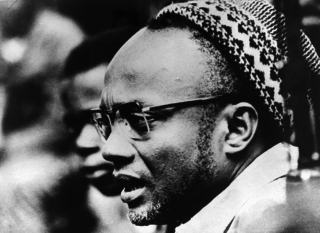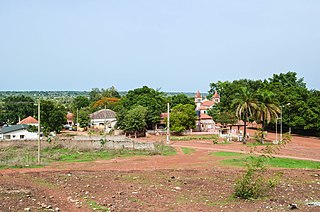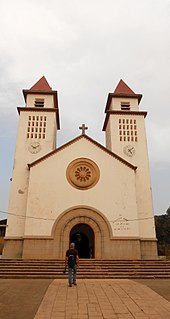Related Research Articles

Guinea-Bissau, officially the Republic of Guinea-Bissau, is a country in West Africa that covers 36,125 square kilometres (13,948 sq mi) with an estimated population of 1,874,303. It borders Senegal to the north and Guinea to the south-east.

The economy of Guinea-Bissau comprises a mixture of state-owned and private companies. Guinea-Bissau is among the world's least developed nations and one of the 10 poorest countries in the world, and depends mainly on agriculture and fishing. Cashew crops have increased remarkably in recent years, and the country now ranks sixth in cashew production.

Bissau is the capital city of Guinea-Bissau. In 2015, Bissau had a population of 492,004. Bissau is located on the Geba River estuary, off the Atlantic Ocean, and is Guinea-Bissau's largest city, major port, and its administrative and military centre.
The music of Guinea-Bissau is most widely associated with the polyrhythmic genre of gumbe, the country's primary musical export. Tina and tinga are other popular genres.

Amílcar Lopes da Costa Cabral was a Bissau-Guinean and Cape Verdean agricultural engineer, intellectual, poet, theoretician, revolutionary, political organizer, nationalist and diplomat. He was one of Africa's foremost anti-colonial leaders.

Portuguese Guinea, called the Overseas Province of Guinea from 1951, was a West African colony of Portugal from the late 15th century until 10 September 1974, when it gained independence as Guinea-Bissau.

Bafatá is a town in central Guinea-Bissau, known as the birthplace of Amílcar Cabral. The town has a population of 22,501. It is the capital of Bafatá Region as well as the seat of the Roman Catholic Diocese of Bafatá, which was established in March 2001 with Carlos Pedro Zilli as bishop.

The Corubal, also known as the Rio Corubal or Tomine, is a river of West Africa, a major tributary of the Geba River. For a short distance, it forms the international border between Guinea and Guinea-Bissau. It has a length of approximately 560 kilometres (350 mi).

There are diverse religions in Guinea-Bissau with no one religion having a majority. The CIA World Factbook states there are about 45% Muslims, 22% Christians, 15% Animists and 18% unspecified or other while the US State Department mentions that estimates vary greatly and cites the Pew Forum data (2010) of 40% Muslim, 31% indigenous religious practices, and 20% Christian. Sunni Islam, including that of Sufi-oriented, are most concentrated in the northern and northeastern parts of the country. Practitioners of traditional indigenous religious beliefs generally live in all but the northern parts of the country. Christians are mostly found along the coastal regions, and belong to the Roman Catholic Church and various Protestant denominations. Christians are concentrated in Bissau and other large towns.
Tabanka is a musical genre of Cape Verdean music

United Nations Security Council resolution 1216 was adopted unanimously on 21 December 1998. After expressing concern at the crisis and humanitarian situation in Guinea-Bissau, the Council called for the immediate establishment of a government of national unity in the National People's Assembly and the holding of elections by the end of March 1999.

This is a survey of the postage stamps and postal history of Guinea-Bissau, formerly known as Portuguese Guinea.
Abdulai Silá, is a Guinea-Bissauan engineer, economist, social researcher and writer. He is the author of three novels: Eterna Paixão (1994), A Última Tragédia (1995) and Mistida (1997), the first of which was the first novel published in Guinea-Bissau.

Guinea-Bissau women's national football team is a FIFA-recognised team representing Guinea-Bissau in international association football matches. Guinea-Bissau have played in two FIFA-recognised matches, both in 2006 against Guinea. The country also has a national under-17 side which participated in the 2012 Confederation of African Football qualifiers for the FIFA U-17 Women's World Cup. Football is the most popular women's sport in the country. A women's football programme was established in 2004, followed by the creation of a women's national league.

Guinea-Bissau made its Paralympic Games debut by sending a delegation to compete at the 2012 Summer Paralympics in London, United Kingdom, having made its Olympic debut at 1996 Games. The delegation consisted of two athletes, Cesar Lopes Cardoso and Ussumane Cande, who both competed in track and field events. Neither athlete won a medal, with neither getting past the first round of their events.

Bissau Cathedral, also known as Sé Catedral de Nossa Senhora da Candelária is a Catholic cathedral in Bissau, Guinea-Bissau. It is the centre of the Catholic Church in Guinea-Bissau. The cathedral is the seat of Diocese of Bissau, which was created in 1977. Situated in the downtown area of Bissau, it is noted for its function as a lighthouse. Services are held in Portuguese language.
The following is a timeline of the history of the city of Bissau, Guinea-Bissau.
Udju Azul di Yonta / The Blue Eyes of Yonta is a 1991 Portuguese film, the second film by the Bissau-Guinean director Flora Gomes. The government of Guinea-Bissau helped in production, together with the Institute of Cinema in Portugal, Vermedia Productions, and Portuguese television.
References
- ↑ New African Yearbook. IC Magazines Limited. 1997. p. 213.
- ↑ Trillo, Richard (2 June 2008). The Rough Guide to West Africa. Rough Guides Limited. p. 1261. ISBN 978-1-4053-8068-3.
- ↑ Africa hoje (in Portuguese). A. Cardoso. 1998. p. 10.
- ↑ África hoje (in Portuguese). A. Cardoso. 1997. p. 201.
- ↑ Mendy, Peter Karibe (17 October 2013). Historical Dictionary of the Republic of Guinea-Bissau. Scarecrow Press. p. 253. ISBN 978-0-8108-8027-6.
| This article about a building or structure in Guinea-Bissau is a stub. You can help Wikipedia by expanding it. |
| This article about a hotel or resort in Africa is a stub. You can help Wikipedia by expanding it. |